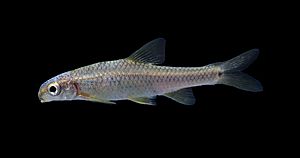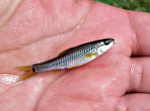Devils River minnow facts for kids
Quick facts for kids Devils River minnow |
|
|---|---|
 |
|
| Conservation status | |
| Scientific classification |
The Devils River minnow (Dionda diaboli) is a small, ray-finned fish. It belongs to the minnow family, called Cyprinidae. This minnow lives alongside other similar fish in parts of northern Mexico and southern Texas.
Contents
Where the Devils River Minnow Lives
The Devils River minnow lives in fresh water. It prefers streams and small rivers fed by springs. These places often have fast-flowing water over gravel and rocks. You can also find them among water plants.
Where to Find the Devils River Minnow
This minnow lives in the Devils River in southern Texas. It is also found in San Felipe Creek, Sycamore Creek, Pinto Creek, and Las Moras Creek. These creeks are in Val Verde County and Kinney County, Texas. In the 1970s, they were also seen in Coahuila, Mexico. This included the Río San Carlos and Río Salado areas. We do not know how many minnows live in northern Mexico today. But they are thought to be rare there.
What the Devils River Minnow Looks Like
The Devils River minnow has dark outlines on its back and side scales. It has double dashes along its side line. A long dark stripe runs from its snout through its eye. It also has a black spot on its tail fin, which is shaped like a wedge. Its body often looks like it has a cross-hatch pattern.
When they are young, their eyes are round. Other young minnows often have oval-shaped eyes. Adult minnows are about 25 to 55 millimeters long. That is about one to two inches. The special shape of their intestines also helps tell them apart. Devils River minnows eat plants. Their intestines are very long and coiled, even when they are young. Minnows that eat insects have straighter intestines.
Life of the Devils River Minnow
These minnows likely live for one to two years. This is based on similar minnow species. Their eggs are a little yellow and clear. Devils River minnows probably lay eggs in the spring. These eggs do not stick to things and sink to the bottom. This is like other minnow species such as Dionda serena and Dionda episcopa.
Male minnows change color when they are ready to mate. Their bodies turn blue-green, and their fins become yellow. The breeding season is in the springtime. We do not know much else about their life. We also do not know their reproduction rate or habits.
What the Devils River Minnow Eats
Scientists have looked at the long, coiled intestines of these fish. This tells us that the minnow eats different kinds of algae. We do not know much more about their diet. More studies or watching captive fish would help us learn more.
Devils River Minnow's Status
The Devils River minnow is listed as endangered by the IUCN Red List. This means it is at high risk of dying out. It was first called "vulnerable" in 1999. But many people wanted it listed as endangered much earlier. Some people still think "vulnerable" is not strong enough. This is because it does not include formal habitat protections. The recovery plan from the U.S. Fish and Wildlife Service in 2005 only suggests voluntary efforts.
Human Impact on the Minnow
This fish is in danger because of many things. Human activities have caused a lot of habitat loss. The Devils River minnow needs clean, flowing spring water to live. But building and farming have greatly reduced this water.
Farm runoff causes most of the pollution in the minnows' home. The minnows cannot handle even small amounts of these pollutants. Building dams, like the Amistad Dam, has also flooded some springs. Water flow from springs has also gone down. This is due to pumping wells and overgrazed soil. These actions lower the water in natural underground areas. This has made the Devils River much smaller. The exact amount of this change is not known. But data from the United States Geological Survey (USGS) shows less water flow from 1978 to 1992.
Once strong groups of minnows have now almost disappeared. This is especially true in Texas. Here, droughts make groundwater even scarcer. Human actions are a main reason for the minnow's decline. But they are not the only reason.
Impact of New Species
Another problem for the Devils River minnow is new species. Some new fish species now compete with the minnow for food and space. These include tropical fish and game fish. Several non-native catfish, cichlids, and bass have moved in. They eat the minnows themselves. They also eat the minnows' main food, which is algae and tiny living things.
Loricariid catfish, in particular, have grown in number in Texas. They are eating most of the available food. Largemouth bass also eat young minnows in winter. This means fewer minnows grow up to have babies. With fewer breeding minnows, the population cannot grow back each season. This leads to a faster decline. The number of Devils River minnows changes with the numbers of their competitors and predators. The Devils River minnow population is clearly shrinking. But people are working to stop this decline.
Helping the Devils River Minnow
When the Devils River minnow was first called "threatened" in 1999, groups worked together. These included the Texas Parks and Wildlife Department, the City of Del Rio, Texas, and the U.S. Fish and Wildlife Service. They made an agreement to help the minnows recover. A special team was formed to carry out this plan.
Luckily, important parts of the minnow's home are owned by the Texas Parks and Wildlife Department and The Nature Conservancy of Texas. But a lot of land is privately owned. The agreement offered help to these landowners. They got advice on how to protect and manage riverbanks. The City of Del Rio and the San Felipe Country Club used this advice for their golf course. They stopped mowing a 10 to 15-foot zone. This helped improve the water quality in San Felipe Creek.
The main goal of the agreement is to keep the springs flowing. This is key for the minnow's long-term survival. They also looked at how live bait was caught and sold in the Devils River area. This was to stop other non-native species from being brought in. As a result, the Texas Parks and Wildlife Department changed its rules. Now, only fish that naturally live there can be used as bait. More research was also encouraged. This would help us learn more and find new ways to help the Devils River Minnow.
In 2005, the U.S. Fish and Wildlife Service made a long-term recovery plan. The goal was to remove the species from the endangered list. This plan deals with habitat problems and new species. It also includes studying the minnow's life. This includes watching how smallmouth bass and Devils River minnows interact. Also, a group of minnows is kept in captivity for study. They are at the TPWD Heart of the Hills Research Station. These minnows can also be put back into the wild.
The nearby city of Del Rio agreed to use 10-20% less water. They are also limiting how many people live near San Felipe Creek. They are checking water quality to reduce pollution. The plan is detailed. But as of April 2011, only seven of thirty-five steps were ongoing. This was almost six years after the plan started.
In 2008, the U.S. Fish and Wildlife Service set aside critical habitat for the minnow. This was under the Endangered Species Act of 1973. This area is 26.5 kilometers of stream. It is in Val Verde and Kinney Counties, Texas. It includes the Devils River, San Felipe, Pinto, Sycamore, and Las Moras Creeks. The Dionda diaboli are still being watched. This is to see how the conservation efforts are working.
- NatureServe. 2013. Dionda diaboli. The IUCN Red List of Threatened Species 2013. Downloaded on 17 August 2017.
See also
 In Spanish: Carpa diabla para niños
In Spanish: Carpa diabla para niños



